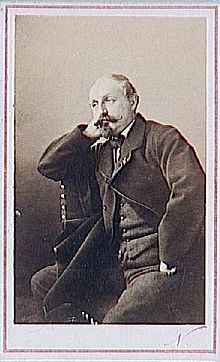Jean-Baptiste Henri Durand-Brager
Jean-Baptiste Henri Durand-Brager | |
|---|---|
 Portrait of Henri Durand-Brager | |
| Born | 21 May 1814 Dol-de-Bretagne, France |
| Died | 25 April 1879 Paris, France |
| Nationality | French |
| Education | Gudin and Eugène Isabey, |
| Known for | Painter and photographer |
| Movement | Orientalism |
Jean-Baptiste Henri Durand-Brager (1814–1879) was a French painter, noted for his marine scenes and Orientalist works.
Life and career

Jean-Baptiste Henri Durand-Brager, a French marine painter, was born at Dol in 1814. He studied under Gudin and Eugène Isabey.[1]
He was a naval officer who rose to the rank of captain.[2] In 1840, he accompanied the fleet which brought Napoleon's remains from St. Helena, which island afforded him subjects for various pictures. He spent much of his time in travelling; he went to Buenos Aires with the squadron, Montevideo in 1841–42 aboard a French warship,[3] and explored Uruguay and Brazil; he accompanied the expeditions to Tangiers and Mogador, and to Madagascar. He painted views of the places he visited, and also naval combats and sea-pieces. He died in 1879.
In the 1850s, he was in the Crimea during the war with Russia, where he turned his hand to photography as well as painting. He was one of about fifteen photographers, including Felice Beato, Roger Fenton and James Robertson, who photographed soldiers, barracks, camp life and battlefields and were the first to record a major war on film.[4] Later, he returned to Constantinople where he made photographs of the landscape, monuments and the people.[5]
He was a versatile painter, producing naval scenes, genre works, costumbrista works, landscapes[6] and works with Orientalist themes. There are several of his works in the galleries of Versailles.
-
The American paddle steamer "De Ruyter" to the rescue
-
Battle of the USS Kearsarge and the CSS Alabama, 1864
-
The Magenta, now in the Musée Thomas-Henry
See also
References
- ^ International Federation of Photographic Art, Camera, C.J. Bucher, 1974, p. 33
- ^ International Federation of Photographic Art, Camera, C.J. Bucher, 1974, p. 33; The Log of Mystic Seaport, Volumes 40-41, Mystic Historical Association, 1988, p.49
- ^ A Guide to the Art of Latin America, 1948, p. 319
- ^ Hewitson, M., The People's War: Histories of Violence in the German Lands, 1820-1888, Oxford University Press, 2017, p. 194; Bustarret, C., Crimée, 1854-1856: Premiers Reportages de Guerre [Exposition du 24 Octobre 1994 au 8 Janvier 1995], Musée de l'Armée, Hotel National des Invalides, Paris, Le Musée, 1994, p. 99 and p. 103
- ^ Öztuncay, B., The Photographers of Constantinople: Text & Photographs, Aygaz, 2003, p. 133; Jacobson, K., Odalisques & Arabesques: Orientalist Photography 1839-1925, Quaritch, 2007, p. 23
- ^ A Guide to the Art of Latin America, 1948, p. 319
 This article incorporates text from a publication now in the public domain: Bryan, Michael (1886). "Durand-Brager, Jean Baptiste Henri". In Graves, Robert Edmund (ed.). Bryan's Dictionary of Painters and Engravers (A–K). Vol. I (3rd ed.). London: George Bell & Sons.
This article incorporates text from a publication now in the public domain: Bryan, Michael (1886). "Durand-Brager, Jean Baptiste Henri". In Graves, Robert Edmund (ed.). Bryan's Dictionary of Painters and Engravers (A–K). Vol. I (3rd ed.). London: George Bell & Sons.



